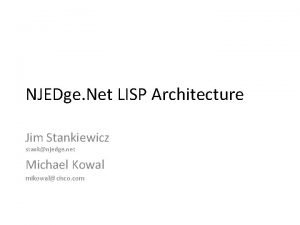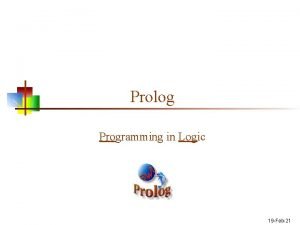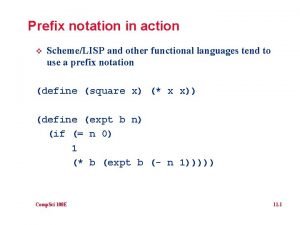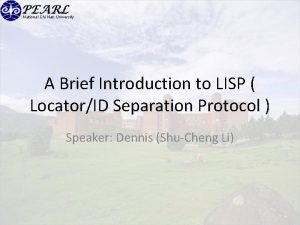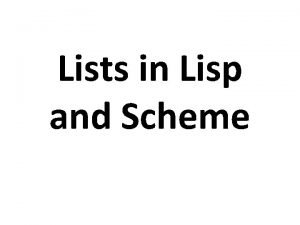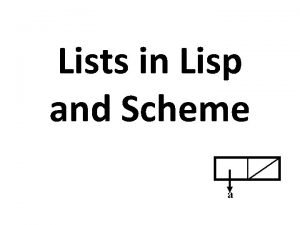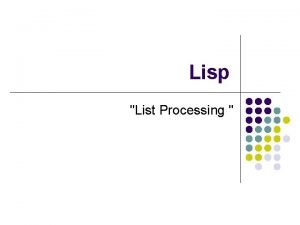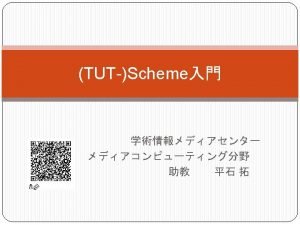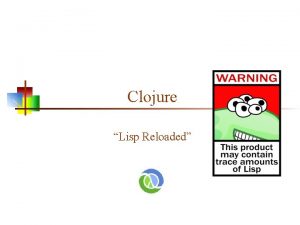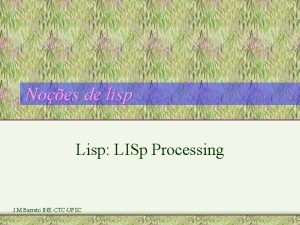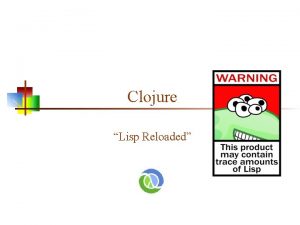NJEDge Net LISP Architecture Jim Stankiewicz stanknjedge net















- Slides: 15

NJEDge. Net LISP Architecture Jim Stankiewicz stank@njedge. net Michael Kowal mikowal@cisco. com

LISP Overview IP addressing overloads location and identity – leading to Internet scaling issues § Why current IP semantics cause scaling issues? − Overloaded IP address semantic makes efficient routing impossible − Today, “addressing follows topology, ” which limits route aggregation compactness − IPv 6 does not fix this § Why are route scaling issues bad? − Routers require expensive memory to hold Internet Routing Table in forwarding plane − It’s expensive for network builders/operators − Replacing equipment for the wrong reason (to hold the routing table); replacement should be to implement new features “… routing scalability is the most important problem facing the Internet today and must be solved … ” Internet Architecture Board (IAB) October 2006 Workshop (written as RFC 4984)

LISP creates a Level of indirection with two namespaces: EID and RLOC EID § EID (Endpoint Identifier) is the IP address of a host – just as it is today § RLOC (Routing Locator) is the IP address of the LISP router for the host MS/MR w. x. y. 1 x. y. w. 2 z. q. r. 5 EID Space EID Non-LISP e. f. g. h Px. TR § Analogous to a DNS Lookup § Network-based solution § Support for mobility § No host changes § Address Family agnostic § Minimal configuration § Uses Pull vs. Push Routing RLOC Space x. TR w. x. y. 1 x. y. w. 2 z. q. r. 5 EID-to. RLOC mapping Prefix Next-hop x. TR w. x. y. 1 x. y. w. 2 z. q. r. 5 RLOC a. a. a. 0/24 b. b. b. 0/24 c. c. c. 0/24 d. d. 0. 0/16 EID § EID-to-RLOC mapping is the distributed architecture that maps EIDs to RLOCs § Incrementally deployable § Open Standard RLOC a. a. a. 0/24 b. b. b. 0/24 c. c. c. 0/24 d. d. 0. 0/16 EID Space

NJEDge. Net Overview NJ’s Research and Education Network Since 2000


NJEDge. Net LISP Deployment • LISP Briefing (June 2011) • CPOC (Aug 2011) • Deploy and Test LISP in Production Environment • First LISP-Production Member (December 2011)

NJEdge LISP Architecture Internet I 2 Internet v 4/v 6 Core MS/MR/Px. TR PHL Member MS/MR/Px. TR NWK

Transition #1 § Member peered with NJEDge and Provider X via BGP § Tuning BGP to properly balance Ingress Traffic Flows was Challenging § Member owned 16 x /24 s Internet NJEDge Provider X Member

Transition #1 § Configure Member for LISP Internet § Remove BGP § Add Two Default routes § Proxy Router attracts Ingress Traffic destined to Member and load balances towards the member. Px. TR Provider X Benefits: • No BGP Configuration to Manage • Guaranteed Ingress Traffic Load Balancing Announce Member Address via BGP NJEDge x. TR Member

Transition #2 § Local, Non. Member peers with Provider X & Y via BGP § Tuning BGP to properly balance Ingress Traffic Flows was Challenging NJEDge Internet Provider X Provider Y Non-Member

Transition #2 § Configure Member for LISP; remove BGP and add two Default routes (one per provider) § Proxy Router attracts Ingress Traffic destined to Member and load balances across both of the Member’s Router interfaces. NJEDge Announce Member Address via BGP Px. TR Internet Provider X Provider Y x. TR Non-Member

Transition #3 § Post-Transition, Member had budget to upgrade elderly Edge Router § Since LISP only “pulls” routing information, smaller memory requirements allow for inexpensive future router purchase. Internet NJEDge Provider X Px. TR Member Map Resolution

Transition #3 Alternative: $17 K (estimated) Original Budget: $28 K (estimated) Assume Hardware Life: 5 -7 years Savings: ~$11 K

Next Steps • Waitlist of 12 Members to be transitioned • Use LISP VM-Mobility to solve Disaster Recovery initiatives.

LISP VM-Mobility Legacy Site LISP Site Px. TR Mapping DB IP Network West DC LISP Updates VM-Move Across Subnets Multi. Tenant Network East DC Data Center 1 Multi. Tenant Compute Data Center 2 Internet LISP routers VM move VM a. b. c. 1
